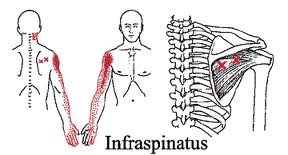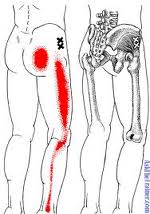Why this could be one of the most powerful ‘pain modifying’ treatments available to you!
Written by Stephen Hooper
Tendonitis?
Rotator cuff pain?
Tennis elbow?
Carpal tunnel syndrome?
Sciatica?
Plantar fasciitis?
What Is A Trigger Point?
Trigger points are commonly described as ‘muscle knots’. These points are hyperirritable spots in skeletal muscle that are associated with taunt bands of muscle fibres. You can often feel these taunt bands by digging your fingers into the muscle and rubbing back and forth. Even mild pressure can cause significant pain and you may feel this pain radiate to other areas of your body.
Trigger points are a common, yet often overlooked, cause of pain!
Acupuncture (Dry Needling)
Dry needling is a treatment approach that has evolved from traditional acupuncture. It refers to the insertion of a fine needle into the muscles and connective tissues of the body to deactivate these trigger points.
Dry needling helps to release these taunt bands and to deactivate the trigger points, which in turn alleviates pain. Dry needling also alleviates muscle tension, increases range of movement around joints, and improves circulation to a given area resulting in a greater healing response and faster healing.
Dry Needling Is Powerful
There are many reasons why this treatment specialty is so powerful. First, if a trigger point is causing (or contributing to) your pain, then dry needling can alleviate your pain immediately. Yes, literally in minutes. In fact, you will likely experience ‘Your Pain’ as the needle releases the offending trigger point. You don’t have to wait for 4-6 sessions to gain pain relief. If your pain generator is a muscle trigger point, then the ‘release’ of that trigger point will result in immediate cessation of your pain. How amazing is that?
 Second. Dry needling is very effective as it can deactivate trigger points that are deep within the muscles (1-10cm). These trigger points can be very difficult to reach with deep tissue massage or Acupressure. In fact, applying pressure to a muscle knott (acupressure) but failing to get the taunt band to ‘let go’, may actually irritate the trigger point and cause an increase in your symptoms. This is quite common and clients may express that their therapist “made their pain worse.”
Second. Dry needling is very effective as it can deactivate trigger points that are deep within the muscles (1-10cm). These trigger points can be very difficult to reach with deep tissue massage or Acupressure. In fact, applying pressure to a muscle knott (acupressure) but failing to get the taunt band to ‘let go’, may actually irritate the trigger point and cause an increase in your symptoms. This is quite common and clients may express that their therapist “made their pain worse.”
Let’s be fair here. Some muscles in the body are up 2 to 5cm in thickness. And the large gluteal musculature can reach 7-10cm in thickness. Imagine the amount of pressure that is needed to reach a trigger point that deep within muscle? Now imagine what those compressive forces are doing to the layers of muscle tissue that sit above the trigger point!
Consider the thickness of the various muscles around the human body. How thick are the chest, shoulder and arm muscles? How thick are the calves, hamstring, quads, and gluteal muscles?
And if you naturally have big muscles or participate in any form of resistance training, then the thickness of your muscle could be even greater.
I have literally had athletic clients (male and female) who had developed 5 to 7cm of muscle on the back of their shoulder blades.
Have you ever come out bruised from a deep tissue massage session? Has it taken several days to recover from this form of therapy? Did this recovery time impact on your ability to work, train or participate in sport? Of course it did.
Now, when you are highly-skilled and know how to use an acupuncture needle effectively, you can safely pass 3-10cm of needle through the healthy tissues above to reach a deep trigger point. And the client doesn’t feel the needle passing through the healthy tissues, they only experience the ‘twitch response’ that occurs when the knot releases. The client cannot tell you whether the ‘twitch response’ occurred at 2cm or 7cm. How powerful is that?
Lastly, dry needling is very successful at deactivating chronic trigger points that ‘won’t let go’ with massage therapy. When taunt bands of muscle tissue occur and then remain taunt for months or even years, it can be really difficult to get them to let go. You often have to ‘work’ at them for a period of time (5-15 minutes) before they will let go. This can be painful for the client and is time consuming. A therapist who is highly-skilled using a needle can use various angles of the needle to gain the ‘twitch response’ and get that stubborn knott to let go. Not only is this far more comfortable for the client, it also saves a lot of time and money.
Case Study – Shoulder Pain
‘Brian’ loved to participate in cross-fit training and competitions. He began to develop pain in his right shoulder that became progressively worse. The sports doctor referred him for an ultrasound scan of the shoulder which demonstrated subacromial ‘bursitis’. Over the next 6 weeks, Brian had two cortisone injections into the bursa to ‘settle things down.’
Unfortunately for Brian, the injections did not help and he continued to experience pain deep in the front of his right shoulder.
The question is whether the ‘bursitis’ seen on the scan was in fact the ‘Pain Generator’ of Brian’s pain or whether another structure was responsible.
Being highly-experienced with bodybuilders, power lifters and cross-fit athletes, I knew that there were other structures and tissues that could be contributing to Brian’s pain pattern. I searched through his neck and shoulder musculature and found numerous ‘active’ trigger points within his rotator cuff muscles.
 Check out the pain pattern for the infraspinatus muscle. When the trigger points are active, the person experiences pain deep inside the shoulder joint. It feels exactly the same as bursitis and tendonitis pain.
Check out the pain pattern for the infraspinatus muscle. When the trigger points are active, the person experiences pain deep inside the shoulder joint. It feels exactly the same as bursitis and tendonitis pain.
I used dry needling to clear taunt bands in his infraspinatus, supraspinatus, teres minor/major and anterior deltoid muscles. Brian lightly stretched these muscles and applied heat over the next 24 hours. When Brian returned for his next appointment, his right shoulder pain had completely resolved.
Case Study – Sciatica
 ‘Jeff’ had always been ‘active’ with a physically demanding job and participation in sport and weight training.
‘Jeff’ had always been ‘active’ with a physically demanding job and participation in sport and weight training.
Over the period of a few months he began to develop lower back pain that became progressively worse. Over the next 6 months he developed pain that radiated down his leg as far as his ankle. The pain was debilitating. An MRI scan showed that he had bulging discs at his L4/5 and L5/S1 levels.
Jeff received various forms of treatment in the coming years including medical management, drug therapy, chiropractic care, physiotherapy treatment and exercise rehabilitation. The intensity of the pain would fluctuate up and down but never resolve. Treatment was always aimed at the bulging discs in his lower back.
 In my first session with Jeff I could clearly see that Jeff’s left hip movement was restricted in various ranges. Palpation of his gluteal muscles revealed deep tissue knotts that were painful to touch. With heavy pressure Jeff stated that his left leg pain intensified.
In my first session with Jeff I could clearly see that Jeff’s left hip movement was restricted in various ranges. Palpation of his gluteal muscles revealed deep tissue knotts that were painful to touch. With heavy pressure Jeff stated that his left leg pain intensified.
I used dry needling therapy to his left quadratus lumborum (QL), gluteus minimus, gluteus medius, piriformis and tensor fascia lata (TFL) muscles.
Immediately, flexion, external rotation and internal rotation of his left hip improved.
Jeff reported at his next session that his ‘sciatica’ pain was 80% better. After two more sessions of therapy, years of chronic pain had completely resolved.
Case Study – Headaches
 ‘Aimee’ was a 26-year-old graphic designer who spent long hours working at her computer. In recent months she had started to experience headaches and ‘migraine-like’ symptoms in the afternoons.
‘Aimee’ was a 26-year-old graphic designer who spent long hours working at her computer. In recent months she had started to experience headaches and ‘migraine-like’ symptoms in the afternoons.
Her neck was tight, she had a deep pain at the base of her skull, and within hours pain developed behind her eyes. It felt like her eyeballs would pop out of her head. It was debilitating pain that was affecting her work.
Medications were initially successful in alleviating her symptoms but more recently they stopped working.
Chiropractic adjustments and deep tissue massage therapy provided temporary relief but the symptoms always returned within a week.
Headaches can be difficult to treat because they can be caused by so many different things. My goal in our first session was to determine if the ‘pain generator’ was neural (nerves) and/or musculoskeletal (muscles, soft tissues, joints) in nature.
The pain pattern that Aimee described was very familiar, I had heard this described hundreds of times by my clients and I knew this pattern well. I quickly turned to page 279 of Travell & Simons’ Trigger Point Manual and showed Aimee the pain pattern for the upper trapezius muscle. She just smiled as the pain pattern almost matched perfectly with what she was experiencing.
 Palpation of her upper trapezius muscles revealed many taunt bands which had a ‘ropey’ feel to them. Dry needling to these bands was difficult as they were well-established and the fascia had tightened making it difficult for the needle to pass through.
Palpation of her upper trapezius muscles revealed many taunt bands which had a ‘ropey’ feel to them. Dry needling to these bands was difficult as they were well-established and the fascia had tightened making it difficult for the needle to pass through.
I was able to elicit several strong muscle twitches from various points within the muscle. This immediately reproduced Aimee’s neck and head pain and she developed some of the ‘migraine-like’ symptoms she had been experiencing. We agreed to take treatment slowly and had two sessions per week for two weeks before symptoms completely resolved.
What causes trigger points to develop?
Trigger points can develop for many reasons and therapists who have advanced qualifications in holistic healing will be able to identify the (individual) causative factors for each of their clients. And then coach them to develop strategies to eliminate or minimize the impact of these causes.
Activation of trigger points may be caused by a number of factors including:
- Acute overload – Heavy lifting or quick acceleration during sport
- Chronic overload – Long hours sitting at computers or training for sport
- Activation by other trigger points – Chest triggers can set off shoulder triggers (Known as satellite or secondary trigger points)
- Direct trauma – An opponent’s knee striking your thigh muscle
- Spinal problems – Nerve dysfunction can lead to trigger points in the muscles
- Deficiencies – Vitamin and mineral deficiencies and/or dehydration
- Toxic overload – Toxicity within organs or glands can cause trigger points in muscles
- Stress – Psycho-emotional stress and tension can cause trigger points in muscles
Dry Needling Is Highly Specialized
This form of therapy is highly specialized & requires years of training & practice.
Physiotherapists, Chiropractors, Osteopaths and massage therapists can all gain dry needling qualifications with as little as two days of training and instruction. It is then up to the therapist to practice this skill continuously to develop and perfect its application. Most professional institutions offering dry needling qualifications have multiple courses with increasing difficulty and requiring advanced clinical skills. However, it’s up to the therapist to take the initiative to further their knowledge and clinical expertise in this area.
The highly-skilled Dry Needling therapist will have:
- Advanced qualifications in applied anatomy and physiology
- Advanced knowledge and clinical skills in assessing and treating the nervous system
- Advanced skills in palpation of the myofascial and skeletal systems
- Advanced qualifications in acupuncture and dry needling
- Thousands of hours of dry needling treatments on a wide range of clients with varying pain patterns
- Advanced qualifications in holistic healing, Holistic Lifestyle Coaching, nutrition or the equivalent so they can understand how trigger points develop and coach their clients in an appropriate manner.
- A copy of Travell and Simons’ Trigger Point Manuals (Volumes 1 & 2) or the equivalent and ongoing study and reference to these manuals regularly.
If you have chronic pain, deep muscle tension, or believe that trigger points could be contributing to your pain or injury, then give us a call today and schedule an initial consult.
About the Author
Stephen Hooper
BSc Physiotherapy
BA Exercise Physiology & Physical Education
Masters in dry needling
Holistic Lifestyle Coach
Author & Professional Speaker
Stephen has 20 years of clinical acupuncture and dry needling experience and has worked with thousands of clients helping them to overcome their pain, injuries and dysfunctions.
